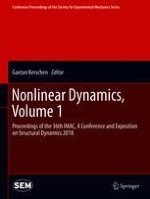2019 | OriginalPaper | Chapter
31. Reduced Order Modelling for Non-linear Rotating Systems in ALE Formulation with Contact
Authors : Tim Weidauer, Kai Willner
Published in: Nonlinear Dynamics, Volume 1
Publisher: Springer International Publishing
Activate our intelligent search to find suitable subject content or patents.
Select sections of text to find matching patents with Artificial Intelligence. powered by
Select sections of text to find additional relevant content using AI-assisted search. powered by
